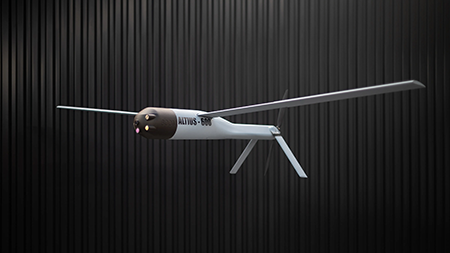“Right after I graduated, I interned with the Arms Control Association. It was terrific.”
U.S. to Supply Taiwan With Attack Drones
September 2024
By Michael T. Klare
The United States has approved its inaugural sale to Taiwan of unmanned aerial vehicles (UAVs) and attack drones. The transaction, announced by the U.S. Defense Security Cooperation Agency on June 18, is worth an estimated $360 million.

Previous U.S. sales to the self-governing island largely have involved major crewed platforms such as F-16 fighters and M-1 Abrams tanks, but the drone sale involves small, man-portable devices employing artificial intelligence and other advanced technologies to locate and attack enemy targets with minimal human oversight.
“Until now, we have no real loitering munition for the army to use. So after about nine months, the U.S. government decided to sell these to Taiwan,” Chen Kuo-ming, a Taipei-based defense analyst, told Defense News.
The Defense Security Cooperation Agency notified Congress of the new arms package on June 18. Because no objection was raised within 30 days, negotiations are proceeding on its final provisions. Although the numbers could change, the package is slated to include the Switchblade 300 loitering munition and the ALTIUS 600M-V multipurpose UAV. Armed drones of this sort largely are intended for use by ground combat forces against an opponent’s armored vehicles, artillery pieces, and command posts located beyond line of sight.
The Switchblade 300, made by AeroVironment, can carry an explosive payload of 3.7 pounds and has a flight range of 30 kilometers and a loiter time of 20 minutes. It is described as a “kamikaze” drone because it is intended to seek out enemy armored vehicles or other enemy assets and crash into them, detonating its payload on impact. The plan is for Taiwan to receive 720 Switchblade missiles plus 101 SB 300 fire-control systems, for a total of $60 million.
The ALTIUS 600M-V UAV, made by Anduril Industries, can be used as a loitering munition as well as a reconnaissance drone or communications relay. It is equipped with electro-optic/infrared cameras for target acquisition and possesses greater range (440 kilometers) and flight endurance (up to four hours) than the Switchblade.
According to Anduril, the ALTIUS 600M-V “has demonstrated autonomous coordinated strike, target recognition, and collaborative teaming,” allowing a single operator to control multiple drones. The proposed sale to Taiwan incorporates up to 291 ALTIUS missiles plus their launch systems and transport trailers, worth a combined $300 million.
The sale of such devices reflects a growing Pentagon consensus that Taiwan could not match China’s military on a one-to-one basis in conventional military platforms, such as tanks, destroyers, and jet fighters. Instead, Taiwan must adopt an asymmetric strategy, using drones and other unconventional weapons to inflict heavy losses if Chinese forces attempt to invade and occupy the island. By providing the Taiwanese with plentiful short-range defensive weapons such as the Switchblade and ALTIUS, U.S. officials hope China will think twice before undertaking an invasion or, if the Chinese military does invade, the assault will be slowed long enough to allow U.S. and other friendly forces to come to the island’s rescue.
The same philosophy undergirds the Pentagon’s Replicator strategy, intended to speed the delivery of small unmanned weapons to U.S. forces in the Indo-Pacific region. “Replicator is meant to help us overcome [China’s] biggest advantage, which is mass. More ships. More missiles. More people,” Deputy Secretary of Defense Kathleen Hicks said when announcing the program in August 2023.
By arming U.S. forces with “multiple thousands” of autonomous weapons systems, she said, “[w]e’ll counter the [Chinese military’s] mass with mass of our own, but ours will be harder to plan for, harder to hit, harder to beat.”
On May 6, Hicks announced that Switchblade drones would be part of the first tranche of munitions to be procured under the Replicator program. “U.S.-supplied Switchblade drones have already demonstrated their utility in Ukraine, and this system will provide additional capability to U.S. forces,” the Pentagon said in a statement.
When viewed together, the decision to supply armed drones to Taiwan and to U.S. forces in the Indo-Pacific region can be seen as part of a larger U.S. strategy for countering China in a future war over Taiwan, a scenario that many Pentagon leaders believe is increasingly likely.
China wants “to offer the world a short, sharp war so that it is a fait accompli before the world can get their act together,” Adm. Samuel Paparo, commander of the U.S. Indo-Pacific Command, told The Washington Post on June 10 in reference to a possible Chinese invasion of Taiwan.
To prevent such an invasion from succeeding, the Pentagon plans to deploy thousands of unmanned ships, planes, and submarines in the region before larger, crewed platforms can arrive in strength.
“I want to turn the Taiwan Strait into an unmanned hellscape using a number of classified capabilities,” Paparo said. That way, “I can make their lives utterly miserable for a month, which buys me the time for the rest of everything.”
